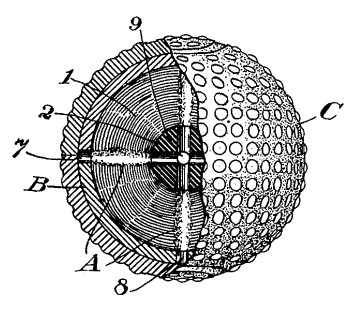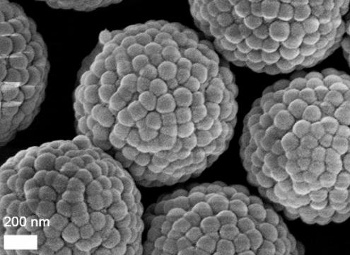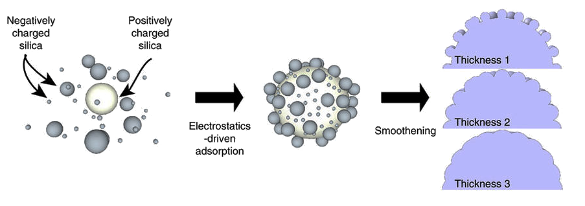Rough Microparticles
July 17, 2017
Billiard balls are
smooth, since they are designed to roll on a flat surface, but most other balls are
rough. In
sports play, such as
basketball and
American football, the roughness helps the player to grip the ball. The dimpled surface of a
golf ball, however, serves a different purpose. A golf ball's dimples aid the
lift of a
spinning ball, a fact discovered
accidentally in 1930.[1-2] They create a thin
turbulent boundary layer of
air at the ball's surface that allows air to flow farther to the backside of the ball and decrease
wake.[1-2]
This lift, called
Magnus lift, is experienced by spinning bodies in a
fluid medium, so it will occur for a ball thrown
underwater. Unfortunately, if the golf ball is not properly hit, and there's sideways spin, it will also
hook or
slice. Magnus lift wasn't a problem for
astronaut,
Alan Shepard, who hit golf balls on the
Moon during the
Apollo 14 mission in 1971 using a
six iron head attached to the
handle of a
scoop used for a
rock sampler. The two actual golf balls that he used are still there.[3]

Figure one of US Patent No. 701,736, "Golf-Ball," by Eleazer Kempshall, June 3, 1902.[4]
In this case, the ball appears to have bumps, not dimples. The beneficial effect of dimples wasn't discovered until 1930.[2]
(Via Google Patents).[4]
While the
The Royal and Ancient Golf Club of St Andrews and the
United States Golf Association has specifications that purposely limit golf ball performance, the only limitation relating to dimples is that a ball's
speed must be less than 270
km/h (250
feet per second) for a particular test condition. There's no limitation on the number of dimples, with numbers around 350 being typical, with a variety of shapes and depths.
Whenever lift is involved, we need to invoke the name of
Swiss mathematician,
Daniel Bernoulli (1700-1782) and his
eponymous Bernoulli's principle. I must confess that I often confuse Daniel with
Jacob Bernoulli (1655-1705), since there are so many
members of the Bernoulli family. Lift is given as a
function of the
differential pressure p on a body, as follows,

In which
v is the
velocity of the fluid (air)
flowing around the body,
g is the
gravitational acceleration,
z is the
height of the body,
ρ is the
density of the body, and the the
constant depends on the important
parameters of the specific case. While a golf ball will exit the
tee at about 80
meters/sec with a spin of about 60
rev/sec, getting the
equation parameters takes a bit of
experimentation, or a lot of
computer modeling. Let's just say, as many of my
professors were
wont to do, that the rest is
left as an exercise for the interested reader.
ignoring for the moment, since
hunting is a
sport, the possible inclusion of
birdshot (2-4 mm) as a sports ball, we have a
panoply of ball examples from
squash balls (40 mm
diameter) through basketballs (755 mm). As
Richard Feynman so
presciently said in 1959, "
there's plenty of room at the bottom." An international team of
scientists from
ETH Zürich (Zürich, Switzerland), the
Leibniz Institute of Polymer Research (Dresden, Germany), and
Sofia University (Sofia, Bulgaria) has been creating
silica (SiO2) microparticles with tunable
surface texture, some of which resemble
raspberries and spherical
colonies of
bacteria.[5-6]

silica raspberries.
scanning electron microscope image of the silica microparticles, showing their controlled surface roughness.
(ETH Zurich image by Michele Zanini, Isa Group.)
These silica "raspberries" were created as an additive to stabilize
emulsions, which are
mixtures of two
immiscible liquids, such as
oil in
water. In an oil-in-water emulsion, small
droplets of oil are dispersed in water.[6] Non-stabilized emulsions will
separate, as the
dispersed droplets merge into larger droplets. A number of
chemical emulsifiers are available to prevent this, such as
surfactants,
polymers, and
proteins.[6] A different type of emulsifier is needed for the two different cases of a oil-in-water emulsions and water-in-oil emulsions. The silica raspberries work in both cases.[6]
In the 1900's, the
British chemists,
W. Ramsden and S. U. Pickering, found that emulsions could be stabilized by very fine
solid particles, such as spherical silica particles.[6] In the present study, the
research team prepared silica spheres of 1-6
micrometer diameter with a roughened surface of smaller diameter silica
nanoparticles. They were able to tune the surface roughness to create a range of candidate emulsifier particles.[6] The idea is that surface
heterogeneities, such as roughness, will significantly affect the
adsorption,
motion and
interactions of particles at the surface.[5]
The rough particles were created by
electrostatically adsorbing
negatively charged silica nanoparticles of 12–250 nm diameter onto the larger, 1-6 μm silica core microparticles that were
positively charged after a surface modification.[5] A modified
Stöber process was used to fill the gaps between smaller surface spheres and seal them together.[5] a library of particles with a broad range of surface roughness was obtained by selection of the size
ratio of the core and surface particle diameters, and the thickness of the grown silica layer.[5]

A diagram of the fabrication process for the rough silica spheres. (Fig. 1(a) of ref. 5, modified for better display, and licensed under a Creative Commons Attribution 4.0 International License.)[5)]
The surface roughness was characterized using
atomic force microscopy, and the
root-mean-squared roughness ranged from 1, for an unmodified core, to 54 nm for particles on a 6 μm core.[5] It was found that these particles will stabilize both water-in-oil and oil-in-water emulsions.[6] An intermediate roughness provided maximum emulsion stability and adsorption efficiency.[5] A
patent application has been filed for production of such particles as emulsion stabilizers, and there are many applications in
foods,
cosmetics, and
pharmaceuticals.[6]
References:
- Craig DeForest, "Why are Golf Balls Dimpled?" on The Original Usenet Physics FAQ, University of California-Riverside Web Site.
- Fluid Mechanics Applications/A07 Dimples on Golf Ball, Wikibooks.
- D.P. Glavin, J.P. Dworkin, M. Lupisella, G. Kminek and J.D. Rummel, "Biological contamination studies of lunar landing sites: implications for future planetary protection and life detection on the Moon and Mars," International Journal of Astrobiology, vol. 3, no. 3 (July, 2004), pp. 265-271, DOI: 10.1017/S1473550404001958
- Eleazer Kempshall, "Golf-Ball," US Patent No. 701,736, June 3, 1902.
- Michele Zanini, Claudia Marschelke, Svetoslav E. Anachkov, Emanuele Marini, Alla Synytska, and Lucio Isa, "Universal emulsion stabilization from the arrested adsorption of rough particles at liquid-liquid interfaces," Nature Communications, vol 8 (June 7, 2017), Article no. 15701, doi:10.1038/ncomms15701. This is an open access article with a PDF file here.
- Peter Rüegg, "Universal stabilisation," Eidgenössische Technische Hochschule Zürich (ETH Zürich) Press Release, June 14, 2017.
Permanent Link to this article
Linked Keywords: Billiard ball; smooth; rough; sports play; basketball; American football; golf ball; lift; angular momentum; spin; serendipity; accidentally; turbulence; turbulent; boundary layer; atmosphere of Earth; air; wake; Magnus effect; Magnus lift; fluid medium; underwater; golf stroke-hook; golf stroke-slice; astronaut; Alan Shepard; Moon; Apollo 14 mission; six iron; handle; shovel; scoop; rock; Google Patents; The Royal and Ancient Golf Club of St Andrews; United States Golf Association; speed; kilometers per hour; km/h; feet per second; Switzerland; Swiss; mathematician; Daniel Bernoulli (1700-1782); eponymous; Bernoulli's principle; Jacob Bernoulli (1655-1705); Bernoulli family; function; differential pressure; velocity; airflow; gravitational acceleration; altitude; height; density; parameter; tee; meters/sec; rotation; rev/sec; equation; experiment; experimentation; computer simulation; computer modeling; professor; wont to do; left as an exercise for the interested reader; hunting; sport; birdshot; panoply; squash ball; diameter; Richard Feynman; prescient; presciently; there's plenty of room at the bottom; scientist; ETH Zürich (Zürich, Switzerland); Leibniz Institute of Polymer Research (Dresden, Germany); Sofia University (Sofia, Bulgaria); silicon dioxide; silica (SiO2); microparticle; surface finish; surface texture; raspberry; raspberries; colony (biology); bacteria; scanning electron microscope; surface roughness; Michele Zanini, Isa Group; emulsion; mixture; miscibility; immiscible; oil; water; droplet; separation process; dispersion (chemistry); dispersed; chemical compound; emulsifier; surfactant; polymer; protein; Great Britain; British; chemist; Pickering emulsion; W. Ramsden and S. U. Pickering; solid; research; micrometer; nanoparticle; heterogeneity; adsorption; motion; Coulomb's law; interaction; electrostatics; electrostatically; negative; electric charge; positive; Stöber process; ratio; schematic; diagram; Creative Commons Attribution 4.0 International License; atomic force microscopy; root-mean-square; patent application; food; cosmetic; pharmaceutical.